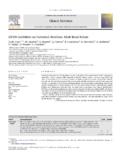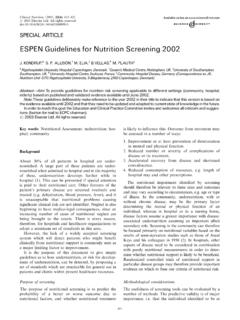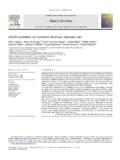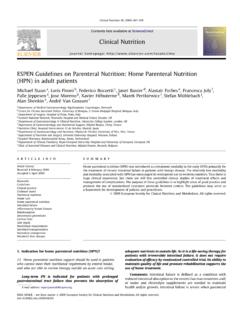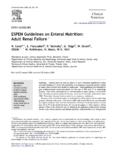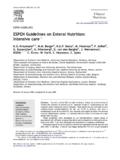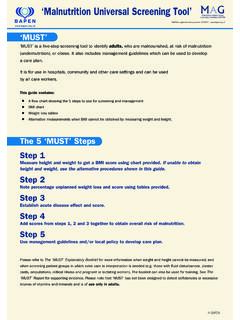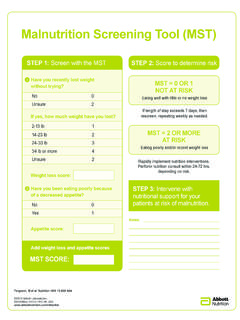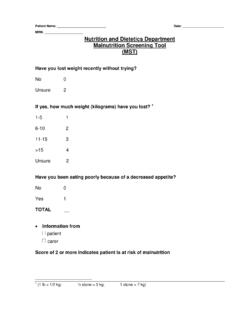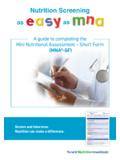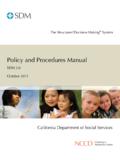Transcription of ESPEN guidelines for nutrition in liver disease and ...
1 Clinical nutrition (1997) 16:43-55 Pearson Professional Ltd 1997 CONSENSUS STATEMENT ESPEN guidelines for nutrition in liver disease and transplantation M. PLAUTH, M. MERLI, J. KONDRUP, A. WEIMANN, P. FERENCI and M. J. MULLER ESPEN CONSENSUS GROUP (Reprint requests and correspondence to MP, IV. Medizinische Klinik, Klinikum Charit# der Humboldt Universit#t, SchumannstraBe 20/21, D-10098 Berlin, Germany, Tel: +49 30 2802 2040/4072/3200, Fax: +49 30 2802 8978) Introduction nutrition has long been recognized as a prognostic and therapeutic determinant in patients with chronic liver dis- ease (1) and was therefore included as one of the variables in the original prognostic score devised by Child and Turcotte (2). Despite the increase in knowledge from research in the fields of metabolism, clinical nutrition and intervention, there is no generally accepted or standardized approach for the diagnosis and classification of malnutrition in these patients.
2 Similarly, there is no general agreement on the criteria for when or how to implement nutritional intervention. Even among clinical trials, criteria for patient classification and study endpoints are heterogeneous and have been used inconsistently. Therefore, ESPEN commi- sioned the work of a group of hepatologists and nutritionists to prepare a consensus document on nutrition in liver disease and liver transplantation . The aim of this consensus was to disseminate current knowledge, propose common terminology, agree consensus definitions and diagnostic and therapeutic standards to be adopted in clinical practice and research, and to stimulate cooperative European studies. The present paper is the result of meetings on the occasions of the annual ESPEN and EASL meetings in Rome 1995 and Geneva 1996, a consensus group meeting in Berlin in 1996 and repeated discussions of circulars at various stages of the work.
3 Effect of liver disease on metabolism and nutritional status Protein-energy malnutrition Acute liver disease induces the same metabolic effects as any disease associated with an acute phase response. The effect on nutritional status depends on the duration of the disease and on the presence of any underlying chronic liver disease which may have already compromised the patients' nutritional status. Malnutrition in chronic liver disease is better defined as protein-energy malnutrition (PEM) because kwashiorkor- like malnutrition and marasmus frequently coexist (3, 4). The prevalence and severity of PEM are related to the clinical stage of chronic liver disease : When diagnosed by anthropometric criteria, PEM may be present in 20% of patients with well compensated liver cirrhosis and in more than 60% of patients with severe liver insufficiency (5). The prevalence is even higher when body composition is assessed by more sensitive methods (4, 6).
4 The presence of muscle wasting indicates an advanced stage and ap- parently is associated with poorer survival (7) particularly following shunt surgery (8). The prevalence and degree of PEM do not appear to relate to the etiology of liver disease per se (4, 5). The higher prevalence of malnutrition in patients with alcoholic liver disease is generally restricted to skid row alcoholics and patients from low socio- economic classes. Conclusion. PEM is common in chronic liver disease and positively correlated with functional severity of the liver injury. 43 Substrate metabolism in chronic liver disease Decreased glucose but increased lipid oxidation are ob- served in postabsorptive cirrhotic patients. This modified substrate utilization does not depend on the nutritional status (9-11). Glucose. The majority of patients with cirrhosis have im- paired glucose tolerance with hyperinsulinemia and insulin resistance.
5 In 15-37% of patients overt diabetes may occur and this represents a risk factor for long-term survival (12, 13). In the postabsorptive state, due to a depletion of hepatic glycogen stores the glucose oxidation rate is reduced and the hepatic glucose production rate iis low despite the increase in gluconeogenesis (14). Under conditions of a euglycemic hyperinsulinemic ,clamp, glucose oxidation is normalized, while non-oxidative glucose disposal is impaired due to reduced glucose trans- port and uptake into skeletal muscle (15, 16). After a meal, insulin resistance is overcome to a degree because of high insulin and glucose levels and cirrhotics utilize the ingested carbohydrate as immediate fuel (17). At present, it is un- known whether glucose deposition as glycogen is impaired just in skeletal muscle or in both muscle and liver (18, 19). 44 ESPEN guidelines FOR nutrition IN liver disease AND transplantation Lipid.
6 In the fasting state, plasma free fatty acids as well as glycerol and ketone bodies are increased. Lipids are oxidized as preferential substrate, and lipolysis is increased with active mobilisation of lipid deposits (10, 20). Insulin apparently does not suppress lipolysis to the same degree as in healthy controls, when plasma free fatty acid and glycerol concentrations are measured during low insulin infusion rates (21). There are controversial findings regarding main- tenance (22) or loss (17) of suppression of postprandial lipid oxidation. Plasma clearance and lipid oxidation rates are not reduced (23, 24) and therefore, the net capacity to store exogenous lipid does not seem to be impaired in cirrhotics. Essential and polyunsaturated fatty acids are decreased in cirrhosis and this decrement correlates with nutritional status (25) and the severity of liver disease (26). Energy expenditure should be measured by indirect calorimetry, especiNly in patients with decompensated cirrhosis.
7 In these patients, no validated factors for esti- mating resting energy expenditure are available. Indirect calorimetry should be used in all metabolic studies. When this method is not available energy expenditure may be calculated from Harris and Benedict's equation (37) as an auxiliary method with a mean deviation of 11% from measured values (9). It remains controversial, however, whether actual, ideal or 'dry' body weight should be used for calculation, since ascites apparently is not an inert compartment regarding energy expenditure (38, 39). Both, actual weight in severe hydropic decompensation or errors in estimates of 'dry' weight may lead to erroneous values deviating to the extremes and therefore, ideal body weight may be accepted as a safe approach. Protein. The effect of insulin on protein metabolism and amino acid disposal does not seem to be impaired in patients with insulin resistance (27).
8 Protein turnover in cirrhotic patients has been found to be normal or increased. Some authors have suggested that protein breakdown is increased, while others suggest that protein synthesis is reduced (28). Nevertheless, stable cirrhotic patients ap- parently are capable of efficient nitrogen retention and significant formation of lean body mass during oral hyper- alimentation (29). Protein catabolism influences the amino acid imbalance of cirrhosis and indirectly causes nitrogen overload to the liver leading to hyperammonemia. Albumin but not fibrinogen synthesis rates correlate with quantitative liver function tests and clinical stages of cirrhosis (30, 31). Conclusions. Substrate metabolism in chronic liver disease is characterized by insulin resistance which affects glucose transport and non-oxidative glucose disposal by skeletal muscle, but does not affect amino acid disposal. Protein turnover occurs at normal or increased rates with an in- crease in protein degradation in some patients.
9 Metabolic clearance and oxidaton of lipids are normal in cirrhosis. Assessment of nutritional status For complete assessment of nutritional status information on energy balance, body composition and tissue function is essential. Energy balance. From analysis of spontaneous dietary intake in control groups of nutritional intervention studies it has become clear that a low intake is associated with a poor outcome (32-35). Despite limitations of the various methods dietary intake should be assessed. In clinical practice a systematic dietary recall obtained by a skilled dietitian will provide adequate information in most cases. For metabolic studies in hospitalized patients, a food diary should be completed, weighing the food consumed, and appropriate tables for food composition should be used for calculaton of proportions of different nutrients. Regarding total energy intake, food analysis by bomb calorimetry may be utilized as a 'gold standard' (29, 36).
10 Body composition. In clinical practice, body composition of cirrhotic patients is assessed by indirect techniques, such as anthropometry, urinary creatinine excretion or bioelectric impedance analysis which are inaccurate, due to the com- bination of reduced body cell mass and a variable degree of extracellular fluid retention (6, 40). Therefore, it would be desirable to directly assess fat mass and fat free mass components total body water, extracellular water and body cell or muscle mass. Anthropometry is a reasonably accurate bedside tool to detect the protein depleted status of cirrhotic patients when used by a single trained examiner (5, 40-42) and four site skinfold anthropometry has been considered the best indirect method of assessing body fat stores in these patients (43). The value of urinary creatinine excretion as a basis to estimate muscle or body cell mass has been questioned since creatine is synthetized by the liver (44).
